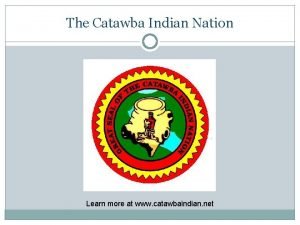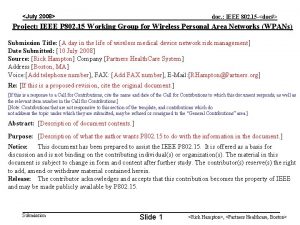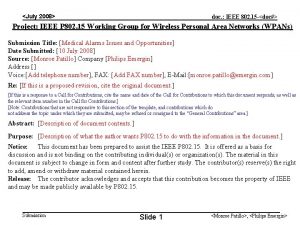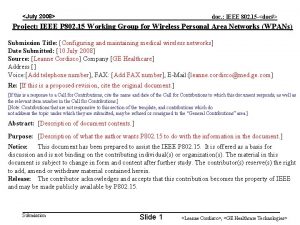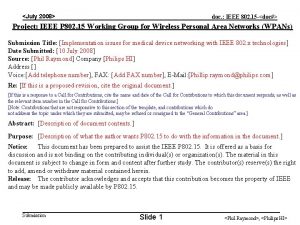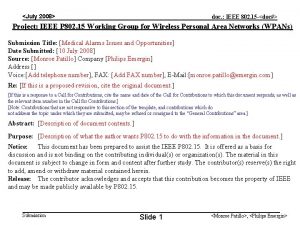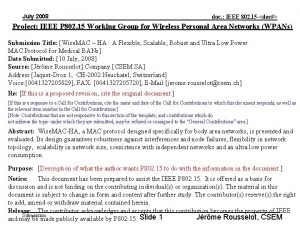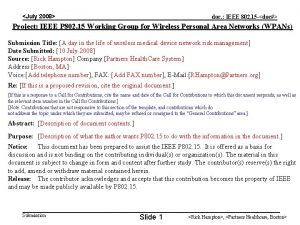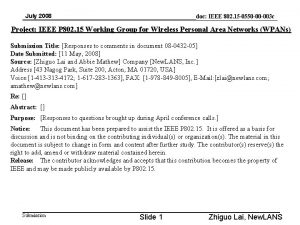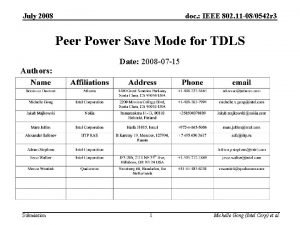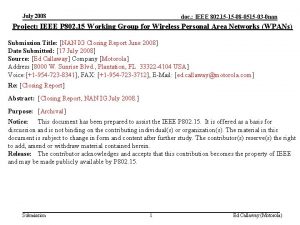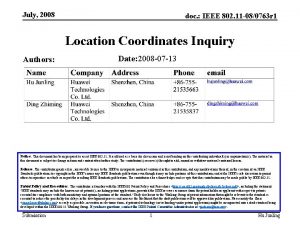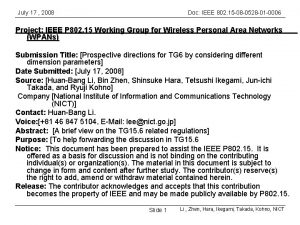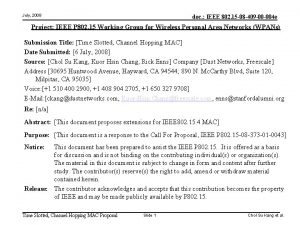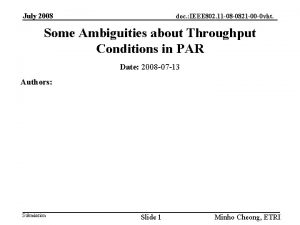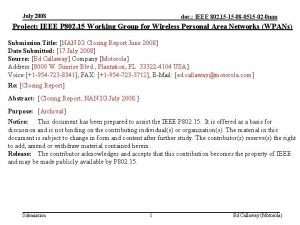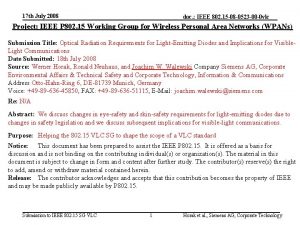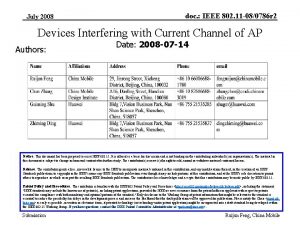July 2008 doc IEEE 802 11 080766 r


























- Slides: 26

July 2008 doc. : IEEE 802. 11 -08/0766 r 0 Group Block Acknowledgements for Multicast Traffic Date: 2008 -07 -07 Authors: Submission 1 Alex Ashley, NDS Ltd

July 2008 doc. : IEEE 802. 11 -08/0766 r 0 Abstract This presentation describes a way to extend the “leader based” approach to any number of reporting STAs This approach is based upon re-using the existing block -ACK mechanisms It has the further advantage of not requiring one (or more) ACKs per multicast frame Submission 2 Alex Ashley, NDS Ltd

July 2008 doc. : IEEE 802. 11 -08/0766 r 0 Leader Based Multicast • One receiving device is elected as a “leader” for a set of group addresses • Leader sends back an ACK if it successfully receives a group addressed frame • AP uses these ACKs (or lack of) to retransmit packets not received by the leader to all members of the group Submission 3 Alex Ashley, NDS Ltd

July 2008 doc. : IEEE 802. 11 -08/0766 r 0 Leader Based Multicast • Assumes errors are correlated such that if leader successfully received frame, all other stations also received it correctly – Random & dynamic nature of WM does not fit well with this assumption • Requires AP to send one frame, wait for an acknowledgment (or time out) before sending the next frame – If LB multicast not enabled, the AP can burst multiple frames – This means power saving STAs have to stay awake for longer Submission 4 Alex Ashley, NDS Ltd

July 2008 doc. : IEEE 802. 11 -08/0766 r 0 Block ACK Setup • To start block ACK, a request is sent – Request contains first sequence number to start using block ACK and a buffer size. Buffer size is max number of frames that the transmitter will keep for possible retransmission. • Recipient replies with Addba. Response – Response says if request has been accepted and a buffer size. Buffer size in Addba. Response defines max number of frames that either the transmitter or receiver needs to keep while the block ACK is active – Receiver creates a re-order buffer for frames of this BA agreement Submission 5 Alex Ashley, NDS Ltd

July 2008 doc. : IEEE 802. 11 -08/0766 r 0 Block ACK • • Submission Once block ACK is active, sending device can send frames with the ACK policy set to BLOCK_ACK – Frames with this policy set are not acknowledged immediately Sending device sends a Block. Ack. Request frame – Requests information on the frames that have been received successfully – Block. Ack. Request must be sent at least as often as the buffer size to ensure that it can retransmit lost frames before the receiver’s buffer overflows Recipient sends a Block. Ack frame – Contains a map of received sequence (fragment) numbers – Sending device can use this Block. Ack frame to discover which frames have been received by the destination and which ones need to be retransmitted. – When a Block. Ack. Request is received, the receiver can empty its receive buffer of all the oldest frames in its buffer that make a continuous set of sequence numbers. Buffer overflow in the receiver – If, after an MPDU is received, the receive buffer is full, the complete MSDU with the earliest sequence number shall be indicated to the MAC client using the MAUNIDATA. indication primitive 6 Alex Ashley, NDS Ltd

July 2008 doc. : IEEE 802. 11 -08/0766 r 0 Block ACK for Multicast STA 2 STA 1 AP 1 STA 4 STA 3 Submission 7 Alex Ashley, NDS Ltd

July 2008 doc. : IEEE 802. 11 -08/0766 r 0 Block ACK for Multicast 1 1 STA 2 STA 1 AP 2 1 STA 4 1 STA 3 Submission 8 Alex Ashley, NDS Ltd

July 2008 doc. : IEEE 802. 11 -08/0766 r 0 Block ACK for Multicast 1 2 STA 1 AP 3 1 2 STA 4 1 2 STA 3 Submission 9 Alex Ashley, NDS Ltd

July 2008 doc. : IEEE 802. 11 -08/0766 r 0 Block ACK for Multicast 1 2 3 STA 2 STA 1 BA 3 R= BA AP 1 2 STA 4 1 2 STA 3 Submission 10 Alex Ashley, NDS Ltd

July 2008 doc. : IEEE 802. 11 -08/0766 r 0 Block ACK for Multicast 1 2 3 STA 2 STA 1 AP 4 1 2 STA 3 Submission 11 Alex Ashley, NDS Ltd

July 2008 doc. : IEEE 802. 11 -08/0766 r 0 Block ACK for Multicast 1 2 3 4 STA 2 STA 1 AP 5 1 2 4 STA 4 1 2 4 STA 3 Submission 12 Alex Ashley, NDS Ltd

July 2008 doc. : IEEE 802. 11 -08/0766 r 0 Block ACK for Multicast 1 2 3 5 1 2 3 4 5 STA 1 =5 STA 2 R BA BA AP 1 2 4 5 STA 4 1 2 4 5 STA 3 Submission 13 Alex Ashley, NDS Ltd

July 2008 doc. : IEEE 802. 11 -08/0766 r 0 Block ACK for Multicast 1 2 3 5 1 2 3 4 5 STA 2 STA 1 AP 4 1 2 4 5 STA 3 Submission 14 Alex Ashley, NDS Ltd

July 2008 doc. : IEEE 802. 11 -08/0766 r 0 Block ACK for Multicast 1 2 3 4 5 STA 2 STA 1 AP 6 1 2 4 5 STA 4 1 2 4 5 STA 3 Submission 15 Alex Ashley, NDS Ltd

July 2008 doc. : IEEE 802. 11 -08/0766 r 0 Block ACK for Multicast 1 2 3 4 5 6 STA 2 STA 1 AP 4 5 6 R= 6 1 2 4 5 BA 1 2 STA 4 BA STA 3 Submission 16 Alex Ashley, NDS Ltd

July 2008 doc. : IEEE 802. 11 -08/0766 r 0 Block ACK for Multicast 1 2 3 4 5 6 STA 2 STA 1 AP 3 1 2 4 5 6 STA 4 1 2 4 5 STA 3 Submission 17 Alex Ashley, NDS Ltd

July 2008 doc. : IEEE 802. 11 -08/0766 r 0 Block ACK for Multicast 1 2 3 4 5 6 STA 2 STA 1 AP 6 1 2 3 4 5 6 STA 4 1 2 3 4 5 STA 3 Submission 18 Alex Ashley, NDS Ltd

July 2008 doc. : IEEE 802. 11 -08/0766 r 0 Block ACK for Multicast 1 2 3 4 5 6 STA 2 STA 1 AP 1 2 3 4 5 6 STA 4 1 2 3 4 5 6 STA 3 Submission 19 Alex Ashley, NDS Ltd

July 2008 doc. : IEEE 802. 11 -08/0766 r 0 Block ACK for Multicast - Setup • AP needs to know which stations are listening to which multicast groups – E. g. snoop on IGMP messages sent by STAs, send out IGMP query messages • AP selects ‘n’ stations from the ‘m’ listening to the multicast group to become block ACK recipients – where 0<n<=m – For each of the ‘m’ stations, the access point sends Addba. Requests – From the resulting Addba. Response frames, AP knows minimum buffer size that can satisfy all ‘m’ stations. Submission 20 Alex Ashley, NDS Ltd

July 2008 doc. : IEEE 802. 11 -08/0766 r 0 Block ACK for Multicast - Setup • AP calculates number of group addressed frames to send before sending a Block. Ack. Request: – Block. Ack. Request. Frequency * n <= Buffer. Size (eqn 1) • By satisfying equation 1, each of the ‘n’ stations will be asked at least once their reception status before its receive buffer becomes full* – This allows at worst case one retransmission of each frame • An improvement can be made by reducing Block. Ack. Request. Frequency: – Block. Ack. Request. Frequency * n * retries <= Buffer. Size (eqn 2) * Assuming all STAs use immediate block ACK Submission 21 Alex Ashley, NDS Ltd

July 2008 doc. : IEEE 802. 11 -08/0766 r 0 Block ACK for Multicast - Operation • After transmitting Block. Ack. Request. Frequency group addressed frames, the AP sends a Block. Ack. Request to a STA from of its list of ‘n’ – Normally first in list, however AP does not select a STA that was the source of any of the packets in its block ACK buffer • The sender of the frame will not have this frame in its receive buffer, so a Block. Ack. Request would erroneously look like a failed reception – Selected STA moves to the back of the list • Typically will not receive another Block. Ack. Request until all other ‘n’ stations have been sent a Block. Ack. Request. • Extra Block. Ack. Requests may need to be sent to STAs not in ‘n’ to stop Block ACK agreement timeout Submission 22 Alex Ashley, NDS Ltd

July 2008 doc. : IEEE 802. 11 -08/0766 r 0 Block ACK for Multicast - Operation • When frames are retransmitted, all STAs listening to this multicast/broadcast will attempt to receive the frame – If reception errors between stations are correlated, the retransmission caused by processing one Block. Ack may provide frames lost by many stations – This technique allows improved reliability even when ‘n’ is less than ‘m’ – This is also why Block. Ack. Requests are staggered between stations, as opposed to sending them at the same time or one after the other. • The Block ACK setup means that there is a delay of up to Buffer. Size frames between a frame first being received and being passed up the software stack – If a lost frame is retransmitted during this delay it will be placed in its correct position in the receive buffer. Submission 23 Alex Ashley, NDS Ltd

July 2008 doc. : IEEE 802. 11 -08/0766 r 0 Legacy Issues • Retransmissions need to be hidden from legacy STAs that do not have active block ACK agreement – They will not have setup a re-order buffer and will probably pass up all received frames • Block ACK requires a TID – For multicast, this needs to be a TID not used by any associated STA (apart from the source of the traffic) • Assumes legacy STA can handle block ACK on group addressed frames – Suggest adding a flag to the Add. Block. Ack. Request to signal group block ACK (E. g. using reserved B 0 of parameter set) – Capability signalling in an IE also a recommended Submission 24 Alex Ashley, NDS Ltd

July 2008 doc. : IEEE 802. 11 -08/0766 r 0 Conclusions • Technique built upon existing 802. 11 technology – Can re-use existing non-AP STA block-ACK implementation – AP needs to keep buffer of sent frames and send periodic Block. Ack. Req frames and schedule retransmits when Block. Ack received • Any number of group members can be used for reception reports • Does not require an ACK on every transmitted frame Submission 25 Alex Ashley, NDS Ltd

July 2008 doc. : IEEE 802. 11 -08/0766 r 0 References 1. “Leader based Multicast. ” Yongho SEOK, Diego DUJOVNE, Thierry TURLETTI, Emily Qi, Menzo Wentink IEEE 802. 11 -07/2128 r 0 Submission 26 Alex Ashley, NDS Ltd
 Bridges from 802.x to 802.y
Bridges from 802.x to 802.y Bridges from 802.x to 802.y
Bridges from 802.x to 802.y Ieee802.22
Ieee802.22 Arquitetura ieee 802
Arquitetura ieee 802 Norma ieee 802
Norma ieee 802 Ieee 802 standard
Ieee 802 standard Bluetooth ieee 802
Bluetooth ieee 802 802 ieee
802 ieee Ieee 802
Ieee 802 Ieee 802 family
Ieee 802 family Ieee 802 3 compliance
Ieee 802 3 compliance 2008 2008
2008 2008 Ieee standard 829
Ieee standard 829 Padrão ieee 754
Padrão ieee 754 June too soon july stand by
June too soon july stand by I am silver and exact i have no preconceptions
I am silver and exact i have no preconceptions Tender mean
Tender mean Recognizing imagery
Recognizing imagery Monday 13th july
Monday 13th july Ctdssmap payment schedule july 2021
Ctdssmap payment schedule july 2021 July 30 2009 nasa
July 30 2009 nasa July 16 1776
July 16 1776 Malaga in july
Malaga in july July 2 1937 amelia earhart
July 2 1937 amelia earhart The cuban melodrama
The cuban melodrama Astronomy picture of the day 11 july 2001
Astronomy picture of the day 11 july 2001 Catawba indian nation bingo
Catawba indian nation bingo


























